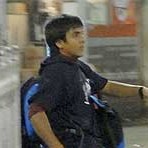
1987 - 2012
Muhammad Ajmal Amir Kasab
Summary
Name:
Nickname:
Kasab / Qasab / Samir Dinesh Choudhari / Abu MujahidYears Active:
2007 - 2008Birth:
July 13, 1987Status:
ExecutedClass:
Mass MurdererVictims:
72Method:
Shooting / Grenade attackDeath:
November 21, 2012Nationality:
Pakistan
1987 - 2012
Muhammad Ajmal Amir Kasab
Summary: Mass Murderer
Name:
Muhammad Ajmal Amir KasabNickname:
Kasab / Qasab / Samir Dinesh Choudhari / Abu MujahidStatus:
ExecutedVictims:
72Method:
Shooting / Grenade attackNationality:
PakistanBirth:
July 13, 1987Death:
November 21, 2012Years Active:
2007 - 2008Date Convicted:
August 29, 2012bio
Muhammad Ajmal Amir Kasab was born on July 13, 1987, in Faridkot village in the Okara District of Punjab, Pakistan. He belonged to a poor Muslim family of the Qassab (butcher) community. His father, Noor Elahi, ran a modest snack cart, while his siblings took up labor work in Lahore. Family life was difficult and marked by poverty. According to reports, an argument with his father during the Eid festival in 2005—over being unable to afford new clothes—triggered Kasab’s decision to leave home. He joined a friend and drifted into petty crime and eventually armed robbery.
In late 2007, during the Islamic holiday of Eid al-Adha, Kasab and his friend encountered recruiters from Jama'at-ud-Da'wah, the political wing of Lashkar-e-Taiba (LeT), distributing pamphlets. Lured by the promise of training, purpose, and a financial incentive for their families, both men enrolled in militant training. Kasab would later claim his father "sold" him to LeT in exchange for around 150,000 Pakistani rupees, although this was denied by his family.
Kasab was trained in both ideological extremism and military tactics. He became part of a selected group of 24 trainees who received advanced marine warfare training near Muzaffarabad, Pakistan-administered Kashmir. The group also trained at the Mangla Dam reservoir and received weapons, navigation, and communication instruction. One of their goals was to mimic the devastation of the 9/11 attacks using urban warfare.
Before the 2008 Mumbai attacks, Kasab’s handlers provided him with a false Hindu identity, complete with a red thread around his wrist and a fake student ID for "Samir Dinesh Choudhari." The plan, as later revealed by police commissioner Rakesh Maria, was to create the illusion that the attack was perpetrated by Indian Hindus and ignite internal conflict.
murder story
On the night of November 26, 2008, Kasab and nine other terrorists infiltrated Mumbai via the Arabian Sea after hijacking an Indian fishing trawler named MV Kuber. They split into pairs and targeted key locations around Mumbai. Kasab, paired with Ismail Khan, was assigned to attack the Chhatrapati Shivaji Terminus (CST), one of India’s busiest railway stations.
Just before midnight, the two entered CST with AK-47s and grenades, opening fire on commuters, killing dozens. CCTV footage later captured Kasab firing indiscriminately while moving through the station. After their initial assault, they moved toward Cama Hospital intending to kill patients. Thwarted by locked doors, they exited the hospital and encountered a police vehicle.
In the ensuing ambush, they killed high-ranking officers including Anti-Terror Squad chief Hemant Karkare, encounter specialist Vijay Salaskar, and Additional Commissioner Ashok Kamte. The duo then stole a police vehicle and continued their spree, killing more civilians before being intercepted by police near Girgaum Chowpatty.
At a police barricade, Khan was killed in a shootout while Kasab survived, pretending to be dead. Assistant Sub-Inspector Tukaram Omble approached their vehicle unarmed and was shot multiple times while restraining Kasab’s rifle, allowing other officers to subdue him. Omble died on the spot but is remembered as the hero who captured the sole surviving attacker.
Kasab initially begged doctors to save his life after seeing his partner’s body. Once in custody, he confessed to the plot, describing how he was brainwashed, fed jihadist ideology, and promised a heavenly reward for martyrdom. His interrogations revealed the location of their GPS devices, the Kuber fishing trawler, and their training bases in Pakistan.
Kasab later tried to retract his confession in court, claiming he came to India to become a Bollywood actor. Despite this, eyewitnesses, video evidence, and his own statements to police were sufficient to convict him.
Kasab’s trial began in April 2009. He was charged with 86 counts, including waging war against India, terrorism, murder, and attempted murder. He initially pleaded not guilty but later confessed in open court. His plea was again retracted months later, but the evidence against him was overwhelming.
On May 3, 2010, he was convicted on all major charges. On May 6, he was sentenced to death. The verdict was upheld by the Bombay High Court in 2011 and by the Supreme Court of India on August 29, 2012. Throughout the legal process, Kasab showed little remorse and occasionally mocked the system.
His mercy petition was denied by Indian President Pranab Mukherjee on November 5, 2012. The decision to execute him was kept secret until November 21. He was moved under tight security from Arthur Road Jail in Mumbai to Yerwada Central Jail in Pune. At 7:30 a.m., he was hanged in secrecy.
Kasab’s final words were, “Allah kasam maaf karna. Aisi galthi dobara nahi hogi.” (“I swear by Allah, please forgive me. I won’t make such a mistake again.”)
He was buried inside the jail premises. Pakistan officially refused to claim his body.